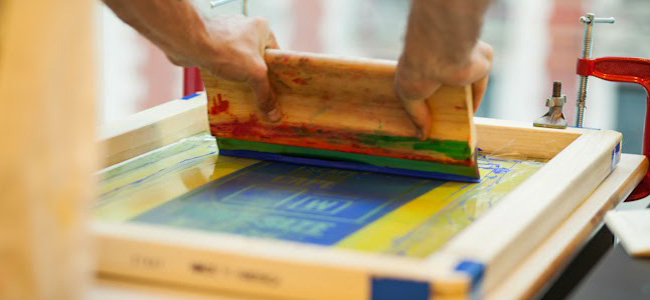Printing by way of screen printing in the era of Digital even though will continue to be needed. Print with screen printing method is indispensable for printing in media which is not possible by Digital and Offset Machine. Automatic screen printing machine is also widely used today, but even so, manual screen printing is of course still done with consideration of cheaper cost, for example Cloth Screen for banner and clothes, T-shirt, Souvenir, screen printing on plastic media and so on.
In this article we will cover the important and basic things about the way and the technique of printing screen printing is done manually one of the printing process that uses the screen (screen) with a certain density and generally the basic bar Nylon or silk.
How it works ?
Silk Screen surface is applied with a special thickened liquid / emulsion. This liquid when applied and dried on the surface of the screen should not be exposed to sunlight (polished and dried in a dark room / In the room without direct sunlight ultra violet). The goal is if exposed to light when it is dry then the polish will not dissolve well with water.
After drying, the surface is sealed / covered with Film from BW (Black / White) printed on transparent plastic or film or can generally use transparent paper from trace.
Followed by “Radiation” process to Sunlight or under light containing Ultraviolet. This irradiation process is determined by counting the time to measure the duration of irradiation and is determined by the loudness of the light that hit the surface of the screening screen.
Move then released from the surface of the screen. The pre-printed movie will “Appear” the duplication of what we have printed on the screen.
Hold next is Watering Screen Surface with water. How to watering should be very careful. Why ??? Because the prints that appear on the screen when exposed to water will dissolve, this is because the film is printed “Black” and the surface of the screen is closed Black will not harden (Because it is not translucent). Vice versa. This is where caution is required in the process of watering which is often accompanied by a tool “Spray water mini” with the aim that the water can be harder and can be good to melt the printed prints.
The next step is the re-drying of the above process. And continue on the Print process with the granting of Ink for printing.
The execution process is by pouring ink on the screen and then swept using a palette or a rubber rack. One screen is used for one color. While the printed material is under a silk screen and the emphasis is placed in such a way. So the screen printing process is each color in one print.
